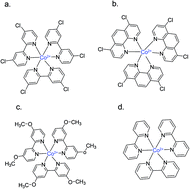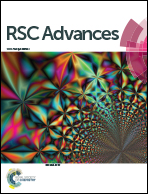Investigation of cobalt redox mediators and effects of TiO2 film topology in dye-sensitized solar cells†
Abstract
One-electron outer-sphere redox couples, such as cobalt metal–organic complexes, represent an interesting alternative as redox mediators in dye-sensitized solar cells since they show weak visible light absorption and available redox potentials may lead to higher open circuit voltage values. Here, we have studied the effect of using different substituents on bipyridyl and phenanthroline ligands in cobalt redox shuttles, giving the following complexes: Co[tris(4,4′-dimethoxy-2,2′-bipyridine)(PF6)2], Co[tris(4,4′-dichloro-2,2′-bipyridine)(PF6)2] and Co[tris(4,7-dichloro-1,10-phenanthroline)(CF3SO3)2], displaying a range of CoII/CoIII redox potentials from +0.37 to +0.79 V vs. NHE. The regeneration kinetics of the organic dye D35 was found to depend systematically on the redox mediator potential, which was explained using Marcus theory. The mass transport of cobalt mediators in dye-sensitized solar cells is highly dependent on the porosity, effective surface area and roughness of the mesoporous TiO2 films. Therefore, films with different TiO2 pore sizes were prepared and investigated to gain an insight into the topological effects of TiO2 film preparation in order to obtain optimum solar cell performance.


 Please wait while we load your content...
Please wait while we load your content...